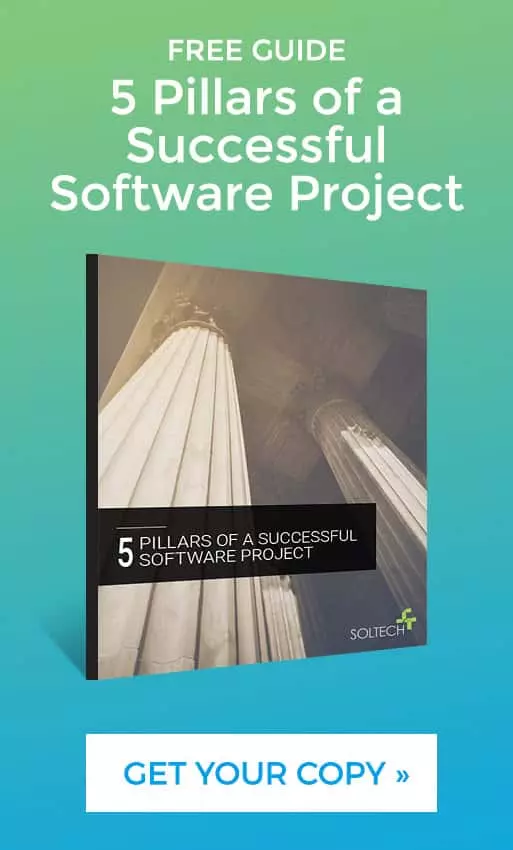
What is an MVP in Software Development?
By Ann Mooney
We’ve all heard of MVPs in sports, but have you ever wondered, “What is an MVP in software?” A Minimum Viable Product, or MVP, is a product management concept that works great when bringing a new product to market.
The essence of MVP is to deliver the bare minimum functionality that will accomplish the need you are trying to fill for your users.
If you were to itemize each feature of your app, ask yourself, “Could my users still get value from my product without this?” If the answer is yes, the MVP strategy says to cut that feature from the initial scope.
This may sound extreme, but the practice of starting with an MVP forces you to think hard about what it is your users actually need and what functionality is important vs. fun, cool, or nice to have.
Creating an MVP product does not mean you won’t ever add in those nice-to-have features. It just means in your first release, you are laser-focused and prioritizing what is truly important. In later releases, you can add new features based on the user acceptance and feedback your MVP has received.
The Benefits of an MVP

Here are just a few of the benefits that an MVP approach will offer your product development initiative:
1. Quicker to Market
Who doesn’t want to launch their product sooner rather than later? The great thing about the MVP app development approach is that you are developing and delivering less functionality out of the gate.
By prioritizing more essential features and components of your software, you’ll be able to get the product in the hands of your users sooner and cheaper than if you went for all the bells and whistles.
Time and Money Restraints
If your company has time or money constraints, an MVP may be the perfect solution for your new product. Working within your budget and prioritizing functions that your users want can help you in the long run. An MVP can begin generating revenue and attracting new users, allowing you to put profits toward further developing your software product. The MVP will also give you time to meticulously develop and test new features before future iterative rollouts.
2. A Clear Product Focus
An MVP approach forces you to find clarity. By adding in lots of functionality, it’s easy to lose focus on the specific problem you are trying to solve. It is easier to be successful by solving one problem and solving it well than by solving several things in mediocre ways.
Challenge yourself to get clear. Clarity drives a strong product and a strong message to your users.
3. You Learn What Your Customers Want
By releasing an MVP, you set yourself up to learn what the customer wants. We all think we understand our users, but the truth is, we don’t. A minimum viable architecture allows you to not waste time guessing and to truly find out.
Once you put an MVP product in the hands of your users, they will tell you what is missing and hence, what is important to them. Based on their feedback, you can prioritize your next set of features and hit your target. This can save you from spending time and resources creating a lot of otherwise unwanted features that serve to only bloat your software.
4. Lower-Risk Investment
Before launching a digital product, it can be difficult to guarantee user interest beyond some basic estimates. Whether you’re going against existing competition or carving yourself a whole new sub-market, building an app is an investment.
Opting for an MVP, you can test the market and gauge the interest of the user base. Even more, you can build a solid audience and garner their loyalty before you begin investing in more costly or time-intensive features. Not to mention, the speed at which you can develop an MVP can quickly let you step into an emerging market to establish yourself while taking time to fine-tune the app.
5. Means to Attract Investors
Even established businesses and companies sometimes struggle with attracting investors for new products and endeavors. Ideas and PowerPoint presentations can only go so far in convincing a venture capital or hedge fund to invest their money for months or years before they can see tangible results.
However, with an MVP, you can quickly put together a viable product to show investors alongside user feedback and real analytics. These tangible results are the best way to attract investors and get funding for the more refined, cost- and time-intensive features.
How To Build an MVP
Building an MVP is somewhat different from planning and building a full software solution. You need to focus on delivering core functionality while minimizing the time and resources expended toward it. Here’s a rough guide to help you navigate the process:
- Identify Core User Needs: Start by trying to understand your target audience. You can conduct in-depth market research and collect user feedback to identify the essential features that your MVP should have.
- Develop a Basic App: Keep the design and architecture simple to expedite development and minimize unnecessary complexities. The goal is to create a functional prototype that demonstrates the core value proposition of your product.
- Gather User Feedback: After launching the MVP, actively seek feedback from early adopters and users. Encourage users to provide insights, suggestions, and critiques to understand any improvements that are needed.
- Gradually Enhance the App: As you gather more feedback and validate assumptions, enhance the app bit by bit with additional features and functionalities.
Measuring Success: KPIs for MVPs
Measuring the success of your MVP as a whole, as well as its individual features, is important for making sure it advances your business goals and addresses user needs. There are multiple Key Performance Indicators (KPIs) that play a vital role in determining the performance of a piece of software.
1. User Acquisition Rates
The goal of an MVP is to widen your user pool and generate interest in your brand and other offerings beyond the app. The acquisition rate tracks the number of new users that sign up for the app, compared to the number of legacy users who were already customers. You can track this by closely following user signups or downloads on the app store.
A higher acquisition rate is a clear, data-driven sign that there is strong market interest in your app. You can also further fragment your data to see how new users are finding the app, whether it’s a friend’s recommendation or a Google search, to more successfully target new users.
2. Activation Rates
While the acquisition rate is the total number of new users, the activation rate follows the users who take specific actions within your app, like making an account or downloading a file.
Having a high activation rate can show interest in specific features and aspects of your app, rather than the software as a whole. You can further use these metrics to optimize the onboarding process of new users for better retention, and even identify pain points that you may be able to solve.
3. User Retention Rates
Attracting users to your app isn’t as important as being able to keep them long-term. User retention rates take longer to measure because they track users who continue to use the product over time; whether it’s a few months or a few years.
A high retention rate means you hit a jackpot of loyal and highly-interested users. However, it’s still important to monitor retention metrics in order to identify patterns of user behavior, as those metrics should influence future updates and marketing strategies.
4. Customer Satisfaction
Customer satisfaction is closely linked to customer retention rates, as satisfied customers are more likely to use your app longer. There are many ways you can gather customer satisfaction metrics, whether it’s through voluntary surveys or third-party review sites.
Customer satisfaction data can help you determine what customers are happy with and what they’d prefer to change about the app. You can use this to guide future updates and features, ordering them by priority depending on the prevalence of a specific request or complaint.
5. Conversion Rates
Similar to the activation rates, conversion rates track how many of your customers who download the free MVP app eventually become paying customers of your services or products. Conversion rates can monitor things like upgrades to premium subscriptions or in-app purchases. A higher conversion rate indicates that you’re successfully able to monetize your app and make a return on your investment.
Remember: User Acceptance is the End Goal
No matter what you’re creating, your software solution will only be a success if your users like it. As a result, the base features you include in your MVP depend largely on your user base.
By taking the time to craft a user persona that captures your target user base, including information such as age, occupation, and daily habits, you can ensure your MVP has features tailored to their needs. If you’ve already targeted this user base in past projects, don’t hesitate to look back on user feedback. Notice which features and updates garnered the most interest and appreciation, and prioritize them in your MVP.
Make a List, Check It Twice
Now that you know your end goal and you’re familiar with your users, it’s time to create a comprehensive list of every feature that you’d like your software to have… eventually.
Once you have your huge list of wants, remembering your users and end goal, go through each one with your development team and decide which features you’ve just got to have and which ones can wait. This new, streamlined list will represent the top priorities for your MVP.
If you’ve identified specific users, you can even have them review the list and share what they’d most like to see right out of the gate. They may even give you some ideas you hadn’t thought of yet. The same rules can be applied in custom home building. If you’re writing down your list of must-haves, consulting with your users (spouse and kids) is a must. After all, they’ll be living there, too… and they outnumber you.
Conclusion
Consider adopting the philosophy “aim small, miss small” in your next product launch. Get laser-focused on who your user is, the primary problem you are trying to solve, and the fewest features needed to provide value. Then create a product that does exactly that. Let your users guide you with reviews and feedback so you can fully understand their needs as you take your next steps.
Before you get started in developing your software app, your thoughts and ideas should be clarified and written down so they can be consistently and easily shared and understood. A company that provides MVP development services can help you further understand your goals and how your MVP can meet them.
To help you get started on the right foot, we have created a checklist. You can grab a copy of that checklist below and share it with your team!
Frequently Asked Questions:
What does MVP mean in software and technology?
MVP in technology refers to Minimum Viable Product. It is a product development strategy that focuses on delivering a fully operational and functional product that only includes the most necessary features, allowing for a quicker market entry and efficient understanding of user preferences.
What does MVP mean in software development?
When it comes to software development, an MVP is a piece of software with core functionality and architecture that’s still capable of fully addressing a user’s needs.
How can I build an MVP app?
To build an MVP app, identify core user needs, prioritize essential features, and develop a basic app. Gather user feedback, iterate based on insights, and gradually enhance the app with additional features over subsequent releases.
What happens after I roll out my MVP software product to my users?
After launching your Minimum Viable Product (MVP), the first priority is to gather and analyze user feedback and usage data. This involves understanding user experiences, identifying likes, dislikes, and issues they encounter, and examining how they interact with your product. Use this information to iterate and improve your MVP, addressing bugs, enhancing the user interface, and adjusting features based on user needs. Regular communication with users is crucial for building a loyal base and for ongoing product development.
Simultaneously, focus on measuring success through key performance indicators like user acquisition, retention rates, and customer satisfaction. If the MVP shows promise, consider scaling the product, securing additional funding if necessary, and ramping up marketing efforts to attract a broader audience. Ensure legal and regulatory compliance, especially in sensitive sectors. Finally, develop a long-term strategy for your product, outlining future features, potential markets, and a growth roadmap, while staying adaptable to changing user needs and market conditions.
Ann Mooney
Director of Business Development Ann Mooney is the Director of Business Development at SOLTECH, and has over 30 years in Sales and Account Management in the Technology, Telecommunications, and Medical Industries. Ann’s key specialties are building long-term business relationships, results-driven sales, and account management.
Ann Mooney is the Director of Business Development at SOLTECH, and has over 30 years in Sales and Account Management in the Technology, Telecommunications, and Medical Industries. Ann’s key specialties are building long-term business relationships, results-driven sales, and account management.
Ann joined SOLTECH in 2016, she works directly with SOLTECH’s clients to help find them the best technology solutions for their business. Ann utilizes her strategic leadership and proactive problem-solving skills to continually grow SOLTECH’s business and ensure excellent customer service.
With her years of experience in the technology industry, Ann likes to share her expertise to educate her audience on the enhancement of workplace productivity and growth through software solutions in her articles. Her insights offer advice on important considerations for creating custom software, including initial steps, development costs, and timelines, as well as the advantages of collaborating with a skilled software development team.




